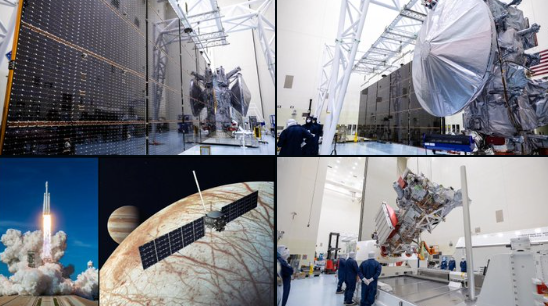NASA’s Europa Clipper mission is scheduled to launch on October 10, 2024. The mission’s primary goal is to investigate Jupiter’s moon Europa, which is believed to have a subsurface ocean beneath its icy surface. This ocean may contain twice as much water as Earth’s oceans, making it a potential habitat for extraterrestrial life. The spacecraft will conduct nearly 50 close flybys of Europa between 2031 and 2034, gathering data on its ice shell, ocean, and overall geology using nine onboard instruments like cameras and ground-penetrating radar Space.com andWikipedia
The NASA spacecraft Europa, named after one of Jupiter’s moons it is set to explore, is poised for a potential launch in mid-October from Kennedy Space Center in Florida. This mission aims to delve into the mysteries of Europa, a moon that is believed to potentially harbor a sub-surface ocean capable of supporting life.
@NASA‘s exciting mission to Jupiter’s moon #Europa, the most promising place in our solar system to find present-day environments suitable for some form of life beyond Earth. #EuropaClipper pic.twitter.com/Qa7Mxa2aei
— Mayank Chhaya, Journalist, Host & Editor, MCR (@MayankChhaya) September 3, 2024
Jupiter, known for its extensive moon system comprising 95 unique moons, finds Europa particularly intriguing due to its potential water-rich environment. Recent findings from NASA’s Juno mission, which orbits Jupiter, have shown that Europa may emit about 1,000 tons of oxygen daily from its surface—enough to sustain a million humans for a day. This discovery, published in Nature Astronomy, highlights the moon’s capacity for supporting life.
To facilitate this ambitious journey, NASA has chosen the powerful SpaceX Falcon Heavy rocket, with a planned launch no earlier than October 10. The exact launch date will be confirmed later this month by SpaceX and NASA. The Europa spacecraft is equipped with nine scientific instruments, including cameras and ice-penetrating radar, designed to investigate beneath the icy surface for life-sustaining elements.
.@NASA and @SpaceX are targeting a launch period opening Thursday, Oct. 10, for the agency’s Europa Clipper mission, which will help scientists determine if one of Jupiter’s icy moons could support life. The mission will launch on a SpaceX Falcon Heavy rocket from Launch Complex… pic.twitter.com/sU8aq2m7OB
— NASA Space Operations (@NASASpaceOps) September 3, 2024
The mission, however, faces challenges, notably concerning radiation exposure in the harsh environment of the Jupiter system. Recent concerns have emerged about a potential flaw in some spacecraft components that may not withstand intense radiation. Teams from NASA’s Jet Propulsion Laboratory, Johns Hopkins Applied Physics Laboratory, and NASA’s Goddard Space Flight Center have been conducting tests to assess if these issues could delay the mission. Initial results suggest the components could still meet the mission’s basic requirements.
SPACEX TO LAUNCH EUROPA CLIPPER MISSION ON OCTOBER 10
NASA and SpaceX are set to launch the Europa Clipper mission on October 10.
The mission will use a SpaceX Falcon Heavy rocket from Kennedy Space Center to study Jupiter’s moon Europa.
It will carry 9 instruments and a… pic.twitter.com/3CzoktEiKQ
— Mario Nawfal (@MarioNawfal) September 3, 2024
NASA plans a final review on September 9 to decide whether the Europa mission can proceed to launch as scheduled, amidst the challenges posed by the demanding space environment around Jupiter.
Major Points:
- NASA’s Europa spacecraft, aimed at exploring Jupiter’s moon Europa, is tentatively scheduled to launch in mid-October from Kennedy Space Center using a SpaceX Falcon Heavy rocket.
- Scientists are particularly interested in Europa because it is believed to host a global liquid ocean beneath its icy crust, which could potentially support life.
- The spacecraft is equipped with nine scientific instruments, including cameras and ice-penetrating radar, to investigate the composition beneath Europa’s surface and assess its habitability.
- There are ongoing investigations into potential radiation issues with some spacecraft components, which could impact the mission’s launch timeline.
- NASA has planned a final review for September 9 to determine if the mission can proceed to launch despite the challenges posed by radiation exposure in the Jupiter system.
Conner T – Reprinted with permission of Whatfinger News



